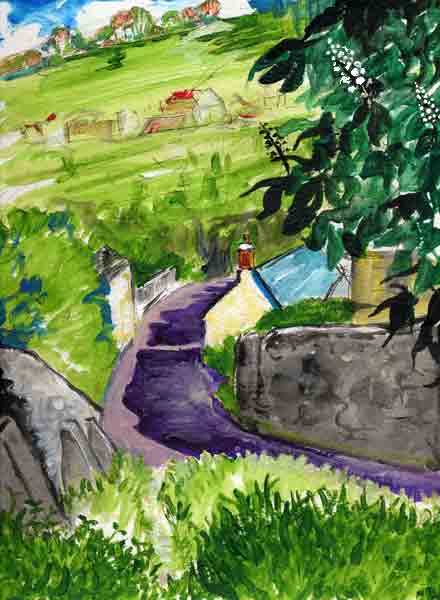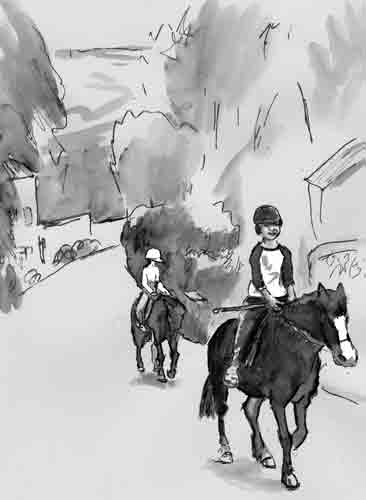The Lyme Maze Game

Shield your head as you descend this lane or take the even steeper shortcut down the triangle of grass: it's October, so small boys are hurling sticks up into the horse-chestnut tree to bring down conkers. PICTURE: conker tree from up right
(But this picture seems to be in May, with the candelabra of flowers still on the tree.) On the left at the top is Knapp House, and the small house lower down, shaped like a segment of Swiss cheese, is Knapp Cottage; knapp, from an old English word cnaepp that generally meant just "hill", seems here to mean the abrupt banks like this that are characteristic of the local scenery. The high stone wall that girds Knapp House's sloping garden has had to be propped with buttresses; and the gate near its top is overgrown with ivy—that is, the ivy covers not the arch but the swinging iron gate itself. Church Street, quite short, dips across a river meadow, to connect the two centres of Uplyme village: the cluster around the church and the southern cluster around the pub and shop. But you're getting tired. Just before the bottom of the dip, you spy a slender lady reading a newspaper (it's the Independent, of course) in the patio in front of Church Cottage on the right. There's something about her . . . You halt and say: "Excuse me, I believe I'm lost. I've been wandering for hours in some sort of maze, and I seem to be farther away from Lyme Regis than when I started. Could you just point me toward it?" She understands at once, can help, but sees that first you need a rest and a cup of tea. You learn from her that this Church Street is a pleasant place to be. The fume-powered traffic is only one-way, but the creature traffic is lively: each morning toward nine the chatter of the "little rugrats"—that's what she affectionately calls them in her astringent American voice—goes up the street toward Mrs. Ethelston's School beside the church. Also the heads of horse-riders bob past the upstairs windows.
(Once a complaint was lodged, presumably by a newcomer, that the horses sometimes use the one-way street in the wrong direction!) Also there's a footpath, along which parties of walkers pass and often have to ask as you did: "Excuse me, where does the path go from here?" The layout is this. Beside Church Cottage is a fallow field called Hacker's Mead. A shady trench at the farther side of the mead conceals the River Lim. Along the nearer side runs the public footpath. And right alongside the cottage, parallel to river and path, is a ditch that was once a leet: that is, a channel carrying water from higher up the river to a mill lower down. (When the mills ceased to operate, the leet ceased to be cleared and was liable to flood, so its intake from the river was closed off and it became dry and in many parts invisible.) The path is designated as part of the East Devon Way. You can see the kissing-gate where it emerges from the meadow. (For Americans: a kissing-gate is one that swings within a sort of V made by two short fences, so that two people who try to go through it at once confront each other; or at least the cheek of the first walker is presented to the second walker.) Along through the meadow, the East Devon Way passes the village hall and playing fields and then rambles up into the hills of Devon. (It wends eventually to Exmouth.) But where does it continue on the eastern side of the road? Opposite, there is what appears to be a private drive, because the wrought-iron gates that are sometimes closed across it have private on them. Nevertheless, that's the way to go. It is the first leg of the path that follows the river toward Lyme. "It keeps changing its character", your informant tells you. "You'll have a wonderful walk. "—Unless", she adds, "you just want to go along the road. "Or, speaking of mazes: before you go, would you like to see the one in our back yard?" (She means what English people call the back garden.) This might be a trick. |

